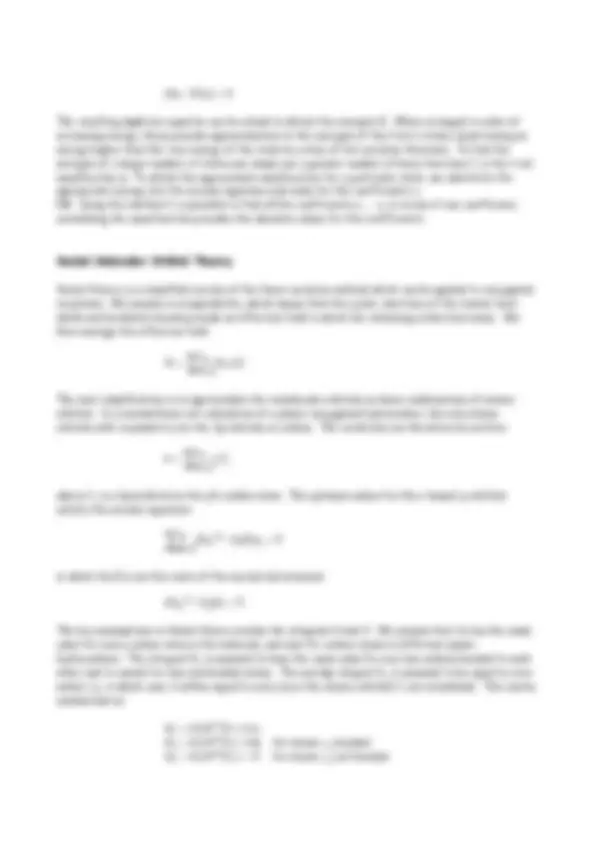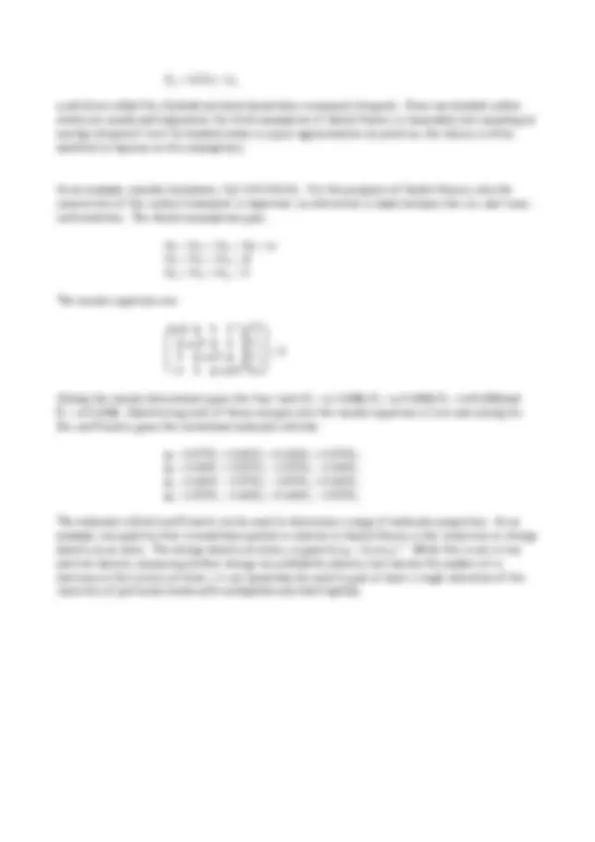




Study with the several resources on Docsity

Earn points by helping other students or get them with a premium plan


Prepare for your exams
Study with the several resources on Docsity

Earn points to download
Earn points by helping other students or get them with a premium plan
Community
Ask the community for help and clear up your study doubts
Discover the best universities in your country according to Docsity users
Free resources
Download our free guides on studying techniques, anxiety management strategies, and thesis advice from Docsity tutors
Linear variation method, Huckel Molecular Orbital Theory are shortly explained
Typology: Lecture notes
1 / 4

This page cannot be seen from the preview
Don't miss anything!



The variation theorem states that given a system with a Hamiltonian H, then if is any normalised, well-behaved function that satisfies the boundary conditions of the Hamiltonian, then
<|H|> Eo (1)
where E 0 is the true value of the lowest energy eigenvalue of H. This principle allows us to calculate an upper bound for the ground state energy by finding the trial wavefunction for which the integral is minimised (hence the name; trial wavefunctions are varied until the optimum solution is found). Let us first verify that the variational principle is indeed correct.
We first define an integral
I = <|H-E 0 |> = <|H|> - <|E 0 |> = <|H|> - E 0 <|> = <|H|> - E 0 (since is normalised)
If we can prove that I 0 then we have proved the variation theorem.
Let i and Ei be the true eigenfunctions and eigenvalues of H, so H i = Ei i. Since the eigenfunctions i form a complete basis set for the space spanned by H, we can expand any wavefunction in terms of the i (so long as satisfies the same boundary conditions as i).
=k a (^) kk
Substituting this function into our integral I gives
I = k akk | H-E 0 |j ajj = k akk | j (H-E 0 ) ajj
If we now use H = E, we obtain
I = k akk | j aj (Ej -E 0 ) j = kj akaj (Ej -E 0 ) k | j = kj akaj (Ej -E 0 ) jk
We now perform the sum over j, losing all terms except the j=k term, to give
I = k ak*ak (Ek-E 0 ) = kak|^2 (Ek-E 0 )
Since E 0 is the lowest eigenvalue, Ek-E 0 must be positive, as must |ak|^2. This means that all terms in the sum are non-negative and I 0 as required.
For wavefunctions that are not normalised, the variational integral becomes:
A special type of variation widely used in the study of molecules is the so-called linear variation function, a linear combination of n linearly independent functions f 1 , f 2 , ..., fn (often atomic orbitals) that satisfy the boundary conditions of the problem. i.e. = i c (^) if (^) i. The coefficients c (^) i are parameters to be determined by minimising the variational integral. In this case, we have:
|H| = i c (^) if (^) i|H|j c (^) j f (^) j = ij c (^) ic (^) j f (^) i|H|f (^) j = ij c (^) ic (^) j Hij where Hij is the Hamiltonian matrix element.
| = i c (^) if (^) i|j c (^) jf (^) j = ij c (^) ic (^) j f (^) i|f (^) j = ij c (^) ic (^) j S (^) ij where Sij is the overlap matrix element. The variational energy is therefore
ij c (^) ic (^) j Hij ij c (^) ic (^) j S (^) ij
which rearranges to give
E ij c (^) ic (^) j S (^) ij = ij c (^) ic (^) j Hij
We want to minimise the energy with respect to the linear coeffients c (^) i, requiring that
c (^) i= 0 for all i. Differentiating both sides of the above expression gives,
E c (^) k^ ij^ c^ i*c^ j^ S^ ij^ + E^ ij^
c (^) i* c (^) kc^ j^ +^
c (^) j c (^) kc^ i*^ S^ ij^ =^ ij^
c (^) i* c (^) kc^ j^ +^
c (^) j c (^) kc^ i*^ Hij
Since cc^ i (^) k* = ik and Sij = Sji, Hij =Hji, we have
c (^) k^ ij^ c^ i*c^ j^ S^ ij^ + 2E^ i^ c^ iS^ ik^ = 2^ ic^ iHik
When Ec (^) k = 0, this gives
ic (^) i(Hi k-ES (^) ik ) = 0 for all k SECULAR EQUATIONS
written in matrix notation, and for a non-trivial solution (i.e. c (^) i 0 for all i), the determinant of the secular matrix must be equal to zero. i.e.
S (^) ij = f (^) i|f (^) j = ij
atoms are usually well separated, the third assumption of Huckel theory is reasonable, but assuming an overlap integral of zero for bonded atoms is a poor approximation (in practice, the theory is often modified to improve on this assumption).
As an example, consider butadiene, H 2 C=CH-CH=CH 2. For the purposes of Huckel theory, only the connectivity of the carbon framework is important; no distinction is made between the cis- and trans- conformations. The Huckel assumptions give:
H 11 = H 22 = H 33 = H 44 = H 12 = H 23 = H 34 = H 13 = H 14 = H 24 = 0
The secular equations are:
0 0 -E
f (^1) f (^2) f (^3) f (^4)
Solving the secular determinant gives the four roots E 1 = -1.618, E 2 = -0.618, E 3 = +0.618 and E 4 = +1.618. Substituting each of these energies into the secular equations in turn and solving for the coefficients gives the normalised molecular orbitals:
1 = 0.372f 1 + 0.602f 2 + 0.602f 3 + 0.372f (^4) 2 = 0.602f 1 + 0.372f 2 – 0.372f 3 – 0.602f (^4) 3 = 0.602f 1 – 0.372f 2 – 0.372f 3 + 0.602f (^4) 4 = 0.372f 1 – 0.602f 2 + 0.602f 3 – 0.372f (^4)
The molecular orbital coefficients can be used to determine a range of molecular properties. As an example, one quantity that is sometimes quoted in relation to Huckel theory is the electron or charge density on an atom. The charge density on atom j is given by qj = i ni|c (^) ij | 2. While this is not a true electron density, measuring neither charge nor probability density, but merely the number of electrons in the vicinity of atom i, it can sometimes be used to give at least a rough indication of the reactivity of particular atoms with nucleophiles and electrophiles.